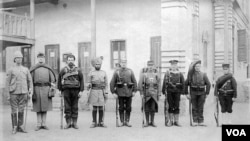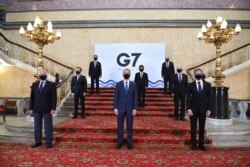A Chinese graphic artist has captured the imagination of Chinese media and public alike with a satirical image depicting today’s G-7 leaders as Victorian-era worthies from a time when China was being carved up by Western colonial powers.
According to a translation by the Chinese Communist Party-backed Global Times, the Mandarin-language caption says: “The last time when these guys colluded to (suppress) China was still in 1900; 120 years have passed, they are still dreaming."
The computer-generated image borrows from a well-recognized historical photo showing members of a military coalition created to suppress Chinese dissent and known as the Eight-Nation Alliance. It was produced by Wuheqilin, a graphic artist with a record of creating nationalistic artwork that has been well received by China’s ruling Communist Party.
His latest image seeks to convey the message that today’s Group of Seven policies and attitudes toward Beijing have not changed in the 120 years since the Boxer Rebellion, a failed effort to drive all foreigners from China.
China’s official media, the China Daily, and the Global Times, which is part of the People’s Daily family, both reported on the image. So did the state-funded Xinhua News Agency, which distributed the China Daily report.
The Communist Youth League’s authenticated Central Weibo account reprinted the composite photo with the text "Have a 120-year dream." Global Times Editor-in-Chief Hu Xijin posted that no matter what the United States does to strengthen its alliances, Washington will not be able to create “a new Eight-Nation Coalition.”
Netzines reposted the image at a rapid pace. "China is no longer the China it was in 1900," posted one. "The world has not changed, only China has changed,” posted another.
The Eight-Nation Alliance was assembled in 1900 after foreign legations in Beijing came under attack during the Boxer Rebellion. The alliance, which has come to represent years of foreign powers’ disrespect for China, is today referenced by official media to generate anti-Western sentiment under the administration of Chinese leader Xi Jinping.
The British propaganda photo shows soldiers from Britain, United States, Australia, British India, Germany, France, Austria-Hungary, Italy and Japan, arranged from tallest (Britain) to shortest (Japan). It was not lost on Chinese that the image captured racial and ethnic stereotypes of the day, when the British Empire spanned the globe.
Wuheqilin took a 2021 group photo from the G-7 foreign ministers’ meeting in London, switched in the soldiers from 1900, gave them all COVID-era masks and posted it to China’s Twitterlike Weibo on May 7, hours after China condemned a May 5 joint statement by G-7 foreign ministers.
During the meeting earlier this month, G-7 leaders accused China of human rights abuses and expressed deep concern about “human rights violations and abuses in Xinjiang and in Tibet." The foreign ministers of the G-7 nations also voiced support for Taiwan and warned China that they would work together to stop Beijing from using “coercive economic policies.”
Wang Wenbin, a spokesperson for China’s Foreign Affairs Ministry, blasted the foreign ministers’ statement at a daily press briefing, saying, “The G-7 foreign ministers' meeting launched groundless accusations against China, blatantly interfered in China's internal affairs and engaged in anachronistic bloc politics. This is gross interference in China's sovereignty, flagrant trampling on norms of international relations, and violation of the trend for peace, development and win-win cooperation of our times. China strongly condemns it.”
The photo contains subtle digs, such as the IV drip near the soldier from India, China’s longstanding rival. The country, which is not part of the G-7, is currently battling a deadly COVID-19 outbreak.
It also offers some obvious jabs, changing the meeting banner from "United Kingdom 2021” to "Invaders United Kingdom 1900."
The post garnered 306,000 likes and 27,500 retweets within five hours, according to the Global Times.
Xiaobing Li, professor of history at the University of Central Oklahoma and recently elected president of Chinese Historians in the United States, told VOA Mandarin that the Chinese government has repeatedly emphasized that China is no longer the China of the 1900s, and that Western countries using the power politics of the past are destined to fail.
"The Chinese media intends to use this cartoon to oppose the hostile attitude of the United States towards China, especially against the United States and other countries' hostile attitude towards China,” he said.
Li suggested that while the image may have encouraged or catered to nationalistic impulses in China, it is another example of how Chinese media manipulation is pushing people into an anti-China stance.
He also said that China should not just use the tragedies of the past to warn the United States but also propose some constructive ways to ease tensions between the world’s two biggest economies.









